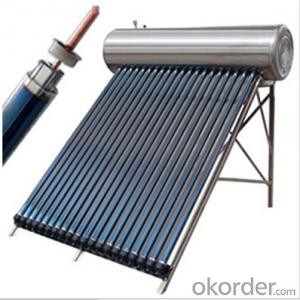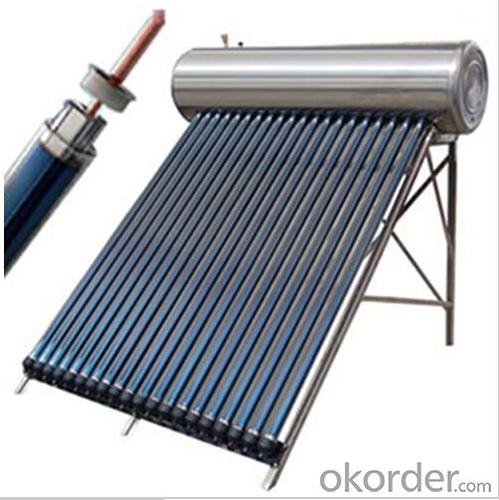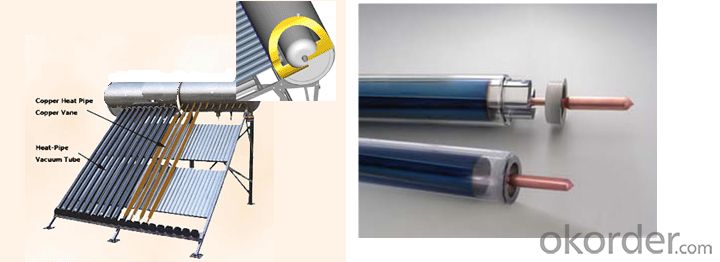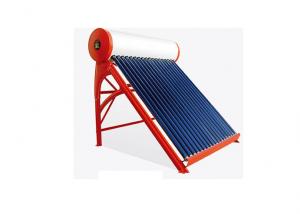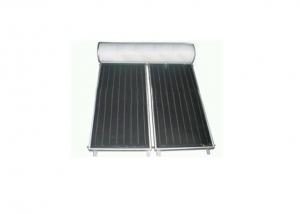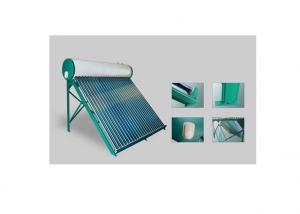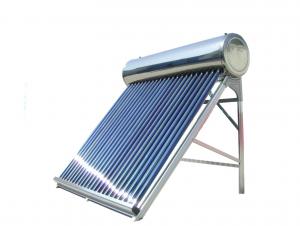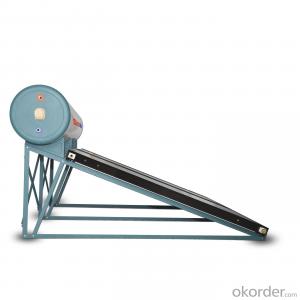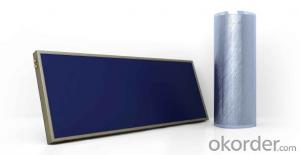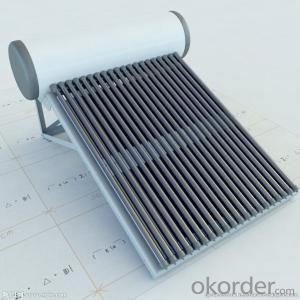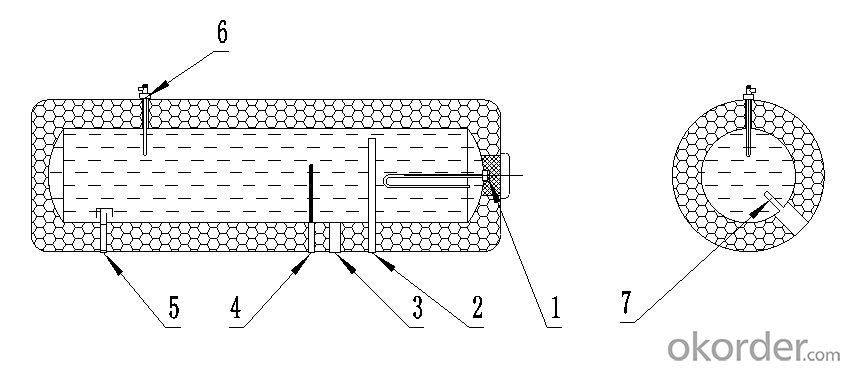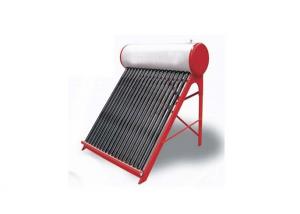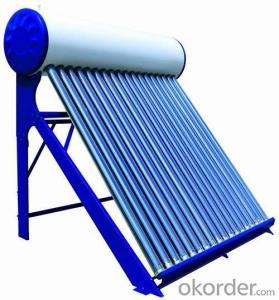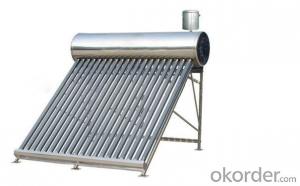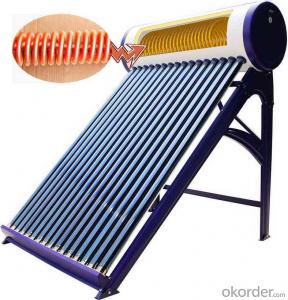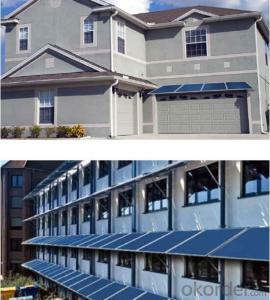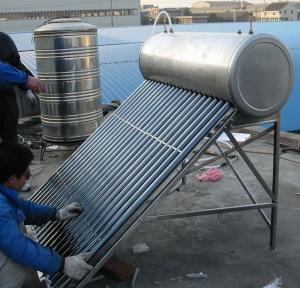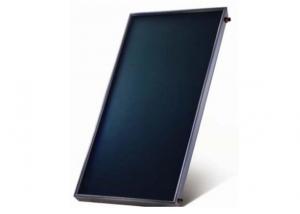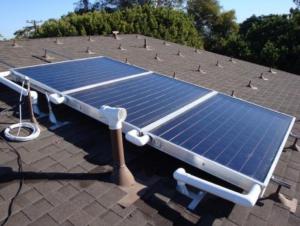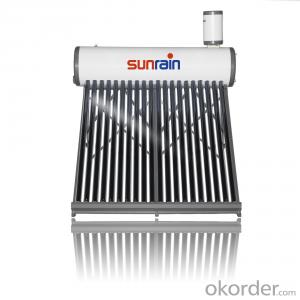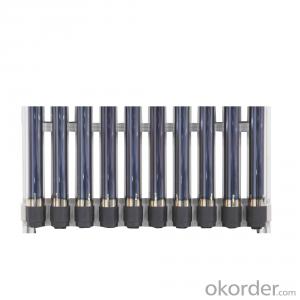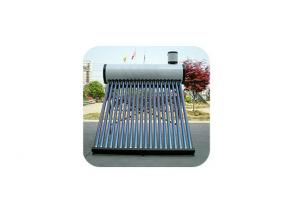Solar Water Heater 200 Ltr Price - Integrative Pressurized Stainless Steel Model SP-HS
- Loading Port:
- Shanghai
- Payment Terms:
- TT or LC
- Min Order Qty:
- 10 set
- Supply Capability:
- 2500 set/month
OKorder Service Pledge
OKorder Financial Service
You Might Also Like
Pressurized Stainless Steel Solar Water Heater Model SP-HS is composed by the following parts as shown in the graphic
1.Water inlet 2.Water outlet 3.P/T Valve 4.Electrical heater 5.Drain vent 6.Sensor hole 7. Heat exchange tube |
|
2.Main Features of the Pressurized Stainless Steel Solar Water Heater Model SP-HS:
(1)Glass vacuum tube solar collector, high temperature,antifreeze,vacuum insulation
(2)Copper heat pipe,Start up quickly,transfers heat quickly, low start-up temperature,low temperature resistant
(3) Food-grade stainless-steel SUS304 2B inner tank,full-automatic welding technology,under the protection of magnesium rod,it can increase of service life
(4)High pressure polyurethane foaming insulation,as the prefect density and the thermal conductivity coefficient is small, so it can provide effective heat preservation
(5)Gravity assisted heat pipe, unilateral heat transfer,high efficiency,low heat loss
3. Pressurized Stainless Steel Solar Water Heater Model SP-HS Images:

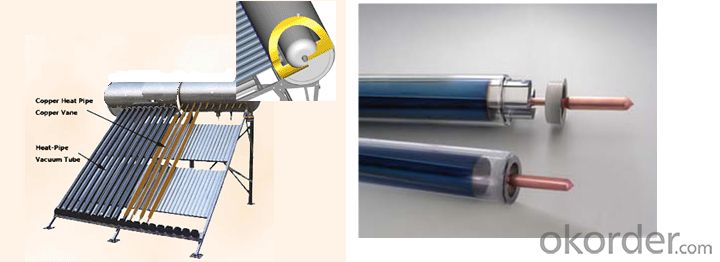
4. Pressurized Stainless Steel Solar Water Heater Model SP-HS Specifications:
Specification & model | SP-H-15 | SP-H-18 | SP-H-20 | SP-H-24 | SP-H-25 | SP-H-30 | ||
Tube QTY(pcs) | 15 | 18 | 20 | 24 | 25 | 30 | ||
Tube spacing㎜) | 75 | 75 | 75 | 75 | 75 | 75 | ||
WATER TANK | ||||||||
Net Volume of Storage Tank(L) | 125 | 145 | 160 | 190 | 200 | 235 | ||
Diamater of inner/outer Tank(㎜) | φ360/φ470 | φ360/φ470 | φ360/φ470 | φ360/φ470 | φ360/φ470 | φ360/φ470 | ||
material and thickness of inner tank(㎜) | SUS304 /t1.2 | SUS304 /t1.2 | SUS304 /t1.2 | SUS304 /t1.2 | SUS304 /t1.2 | SUS304 /t1.2 | ||
material of outer tank | stainless steel | stainless steel | stainless steel | stainless steel | stainless steel | stainless steel | ||
material of insulation | polyurethane | polyurethane | polyurethane | polyurethane | polyurethane | polyurethane | ||
Size of electrical heater hole | 11/4″ | 11/4″ | 11/4″ | 11/4″ | 11/4″ | 11/4″ | ||
Cold water inlet hole | 3/4″ | 3/4″ | 3/4″ | 3/4″ | 3/4″ | 3/4″ | ||
Hot water outlet hole | 3/4″ | 3/4″ | 3/4″ | 3/4″ | 3/4″ | 3/4″ | ||
T/P valve hole | 3/4″ | 3/4″ | 3/4″ | 3/4″ | 3/4″ | 3/4″ | ||
Drain vent hole and Magnisium hole | 3/4″ | 3/4″ | 3/4″ | 3/4″ | 3/4″ | 3/4″ | ||
Sensor hole | 1/2″ | 1/2″ | 1/2″ | 1/2″ | 1/2″ | 1/2″ | ||
Vacuum Tube | ||||||||
Diameter/Length(㎜) | φ58/1800 | φ58/1800 | φ58/1800 | φ58/1800 | φ58/1800 | φ58/1800 | ||
Material | High boron and silicon glass 3.3 | High boron and silicon glass 3.3 | High boron and silicon glass 3.3 | High boron and silicon glass 3.3 | High boron and silicon glass 3.3 | High boron and silicon glass 3.3 | ||
Outside thickness(㎜) | 1.8 | 1.8 | 1.8 | 1.8 | 1.8 | 1.8 | ||
Inside thickness(㎜) | 1.6 | 1.6 | 1.6 | 1.6 | 1.6 | 1.6 | ||
Light transmission rate | ≥0.90 | ≥0.90 | ≥0.90 | ≥0.90 | ≥0.90 | ≥0.90 | ||
Vacuum degree (Pa) | <10^-2 | <10^-2 | <10^-2 | <10^-2 | <10^-2 | <10^-2 | ||
Coating absorption | ≥0.90 | ≥0.90 | ≥0.90 | ≥0.90 | ≥0.90 | ≥0.90 | ||
Coating emittance | ≤0.07 | ≤0.07 | ≤0.07 | ≤0.07 | ≤0.07 | ≤0.07 | ||
Average heat loss coefficient | ≤0.75W/(㎡·℃) | ≤0.75W/(㎡·℃) | ≤0.75W/(㎡·℃) | ≤0.75W/(㎡·℃) | ≤0.75W/(㎡·℃) | ≤0.75W/(㎡·℃) | ||
Frame | 2 feets ( left-to-right ) | 3 feets ( left-middle-right ) | ||||||
Material | Galvanized steel t1.2 | Galvanized steel t1.2 | Galvanized steel t1.2 | Galvanized steel t1.2 | Galvanized steel t1.2 | Galvanized steel t1.2 | ||
Angle | 45° | 45° | 45° | 45° | 45° | 45° | ||
Tube support Specification/hole distance(㎜ | φ58/75 | φ58/75 | φ58/75 | φ58/75 | φ58/75 | φ58/75 | ||
Accessories: | ||||||||
Tube sealing ring | Silicon rubber/φ58 | Silicon rubber/φ58 | Silicon rubber/φ58 | Silicon rubber/φ58 | Silicon rubber/φ58 | Silicon rubber/φ58 | ||
Tube dusting rings | Silicon rubber/φ58 | Silicon rubber/φ58 | Silicon rubber/φ58 | Silicon rubber/φ58 | Silicon rubber/φ58 | Silicon rubber/φ58 | ||
Tube holder | ABS/φ58 | ABS/φ58 | ABS/φ58 | ABS/φ58 | ABS/φ58 | ABS/φ58 | ||
Item Size:: | ||||||||
a (㎜) | 1385 | 1610 | 1760 | 2060 | 2135 | 2510 | ||
b (㎜) | 1110 | 1335 | 1485 | 1785 | 1860 | 2235 | ||
c (㎜) | 1700 | 1700 | 1700 | 1700 | 1700 | 1700 | ||
c/2 (㎜) | —— | —— | —— | 892.5 | 930 | 1255 | ||
d (㎜) | 1430 | 1430 | 1430 | 1430 | 1430 | 1430 | ||
5. FAQ
(1). How do I protect my solar system during subzero temperatures?
If you have a system that is operating in areas with subzero temperatures then freeze protection must be implemented. The easiest means of preventing freezing is to use a controller with a low temperatures setting, so when the manifold temperature drops below a certain pre-set temperature (5oC/40oF), the pump will circulate, warming the collector with water from the bottom of the storage tank. The pump will not run continually, just periodically, the frequency of which will depend on the outside temperature. In extremely cold areas, a closed loop using a glycol/water mix may be appropriate.
(2). Will water be heated on a cloudy day?
Yes. Although the heat output of the solar collector is reduced on overcast days it will still be able to provide heating. If it is a heavily clouded day or raining, then more gas or electric boosting may be required to maintain water at the required temperature. This system will be automated so you don't have to worry about running out of hot water on a rainy day.
- Q: Can a solar water heater be used in areas prone to hurricanes or earthquakes?
- Yes, a solar water heater can be used in areas prone to hurricanes or earthquakes. However, it is important to ensure that the system is properly installed and secured to withstand the potential impact of these natural disasters. Additionally, regular maintenance and inspection should be carried out to ensure its continued functionality and safety in such areas.
- Q: Can a solar water heater be used in areas with limited tidal power resources?
- Yes, a solar water heater can definitely be used in areas with limited tidal power resources. Tidal power is a renewable energy source that harnesses the power of ocean tides to generate electricity. However, it is not directly related to the functioning of a solar water heater. A solar water heater utilizes solar energy from the sun to heat water for domestic or industrial use. It consists of solar collectors, which absorb sunlight and convert it into heat, and a storage tank that stores the heated water. The system is typically designed to work efficiently in areas with ample sunshine. Unlike tidal power, solar energy is abundant in most regions of the world, regardless of proximity to the ocean. As long as an area receives a sufficient amount of sunlight, a solar water heater can be used effectively. Therefore, the availability of tidal power resources does not impact the viability of using a solar water heater. In fact, in areas with limited tidal power resources, solar water heaters can be an excellent alternative to traditional water heating methods that rely on non-renewable energy sources. By harnessing solar energy, these systems can significantly reduce reliance on fossil fuels, lower carbon emissions, and provide cost savings on energy bills. So, although tidal power is an exciting renewable energy source, its availability does not determine the feasibility of using a solar water heater. Solar water heaters are versatile and can be utilized in areas with limited tidal power resources, as long as they receive sufficient sunlight.
- Q: Can a solar water heater be used in areas with limited access to electricity infrastructure?
- Areas with limited access to electricity infrastructure can effectively use solar water heaters. These heaters operate by harnessing energy from the sun to heat water, eliminating the need for electricity. They consist of a solar collector, which absorbs the sun's rays and transfers the energy to the water, and a storage tank to hold the heated water. In regions with limited electricity infrastructure, solar water heaters offer a dependable and economical solution for obtaining hot water. By solely relying on the sun's energy, they can provide hot water even in remote locations or areas with unreliable electricity supply. Solar water heaters are designed to be efficient and easy to maintain. They can be built using simple and sturdy materials, making them suitable for deployment in resource-constrained regions. Moreover, solar water heaters have a long lifespan, reducing the frequency of replacements or repairs. By utilizing solar energy, these systems also help reduce carbon emissions and decrease reliance on fossil fuels. This makes them environmentally friendly and sustainable alternatives to traditional water heating methods that depend on electricity or non-renewable energy sources. In summary, solar water heaters are a practical and viable choice for areas with limited access to electricity infrastructure. They offer a reliable, cost-effective, and environmentally friendly means of obtaining hot water, making them an excellent option for off-grid or remote locations.
- Q: How does a solar water heater impact home resale value?
- A solar water heater can positively impact home resale value by increasing the overall energy efficiency of the property. This environmentally-friendly feature can be attractive to potential buyers looking to save on utility costs and reduce their carbon footprint. Additionally, the presence of a solar water heater may differentiate the home from others on the market, potentially leading to a higher selling price and quicker sale.
- Q: Method for using solar water heater
- H, how to extend the life: in order to extend the service life of solar water heaters, users in the use of the process should pay attention to the following points:1, the installation of the water heater is fixed, non professionals do not easily move, uninstall, to avoid damage to critical components.2, the water heater should not be placed around the debris, in order to eliminate the impact of vacuum tubes.3, regularly check the exhaust hole, to ensure smooth, so as to avoid swelling or pumping water tank.4, regular cleaning vacuum tube, be careful not to touch the tip of the vacuum tube.5, winter should prevent cracking pipes, and ensure the smooth exhaust pipe.6, auxiliary electric heating device of solar water heater should pay special attention to water, to prevent dry burning.
- Q: What are the requirements for the installation of solar water heaters?Why do you install this?
- In sunny days, the temperature of the solar water heater can reach 70 degrees, in the bath must be hot and cold water. First open the cold water valve, the appropriate regulation of cold water flow, and then open the hot water valve adjustment until the temperature, flow meet the requirements. Pay attention not to the head of the body, so as not to burn. Most of the water tank of solar water heater is not pressure bearing structure, the top of the water tank overflow port and exhaust port must not be blocked, otherwise it will cause too much pressure on the tank water tank rupture. If the water pressure is too high, when the water valve opening degree to be smaller, to avoid too late because of the expansion of the water tank.
- Q: What are the components of a solar water heater?
- The components of a solar water heater typically include a solar collector, a storage tank, a heat exchanger, a pump or circulation system, and controls. The solar collector absorbs sunlight and converts it into heat energy, which is transferred to the water in the storage tank through a heat exchanger. The circulation system or pump ensures the movement of water between the collector and storage tank, while the controls regulate the temperature and ensure efficient operation of the system.
- Q: What are the common maintenance issues with a solar water heater?
- Some common maintenance issues with a solar water heater include scaling and mineral buildup, leaky pipes or valves, malfunctioning temperature or pressure sensors, and occasional repairs or replacements of components such as pumps or controllers. Regular cleaning, inspection, and proper maintenance can help prevent and address these issues, ensuring optimal performance and longevity of the solar water heater system.
- Q: How to clean solar water heater
- Specific method is:1, when all the water in the water tank is completed, each vacuum tube with both hands to hold back and forth rotation, so that the vacuum tube and the water tank on the loose ring, and then pushed into the tank;2, when the bottom of the vacuum tube can be removed from the fixed base, then the vacuum tube out of the water tank out;
- Q: Are there any noise-related issues with solar water heaters?
- No, solar water heaters do not produce any noise as they operate silently, making them a quiet and efficient option for heating water.
Send your message to us
Solar Water Heater 200 Ltr Price - Integrative Pressurized Stainless Steel Model SP-HS
- Loading Port:
- Shanghai
- Payment Terms:
- TT or LC
- Min Order Qty:
- 10 set
- Supply Capability:
- 2500 set/month
OKorder Service Pledge
OKorder Financial Service
Similar products
Hot products
Hot Searches
Related keywords
